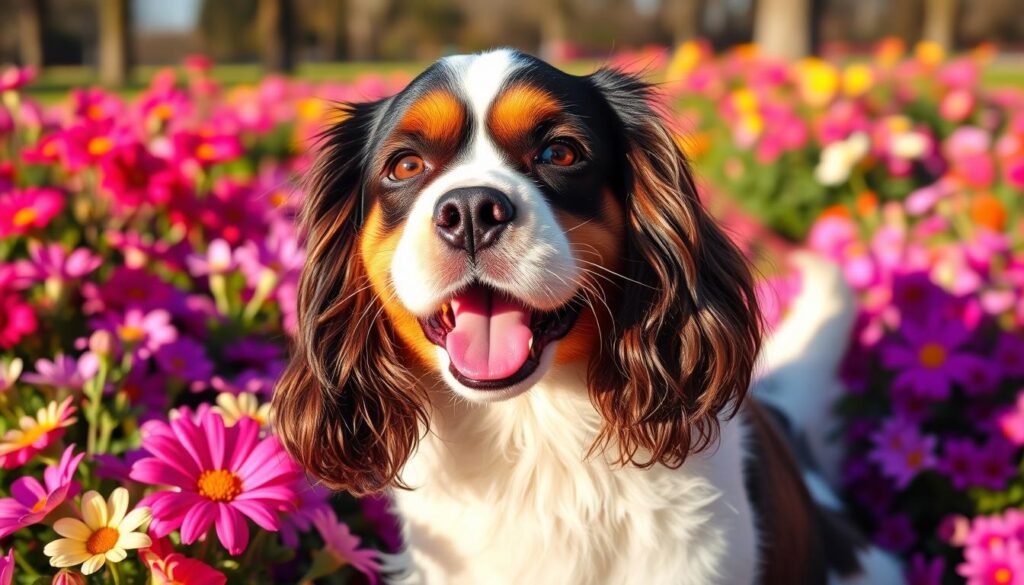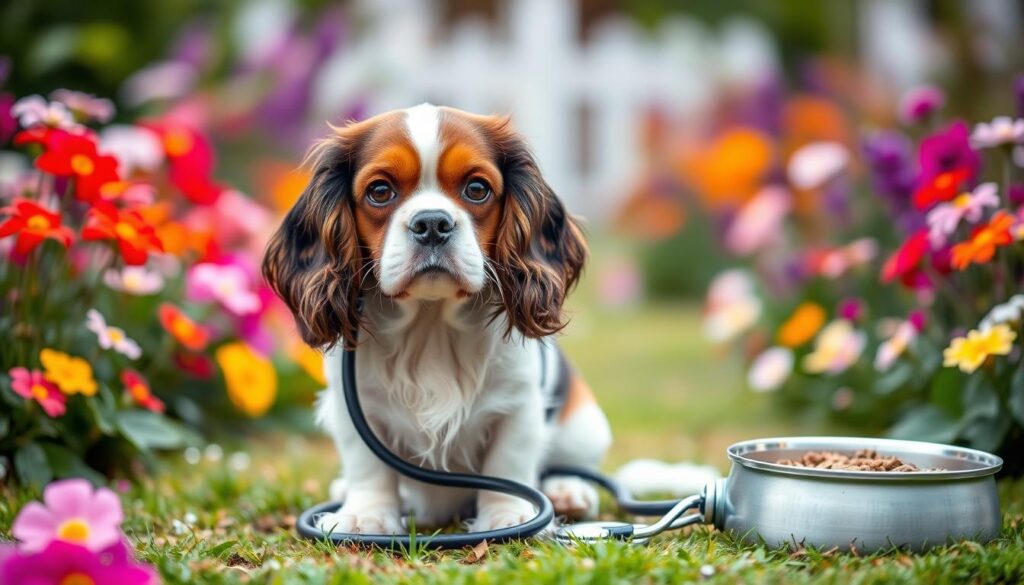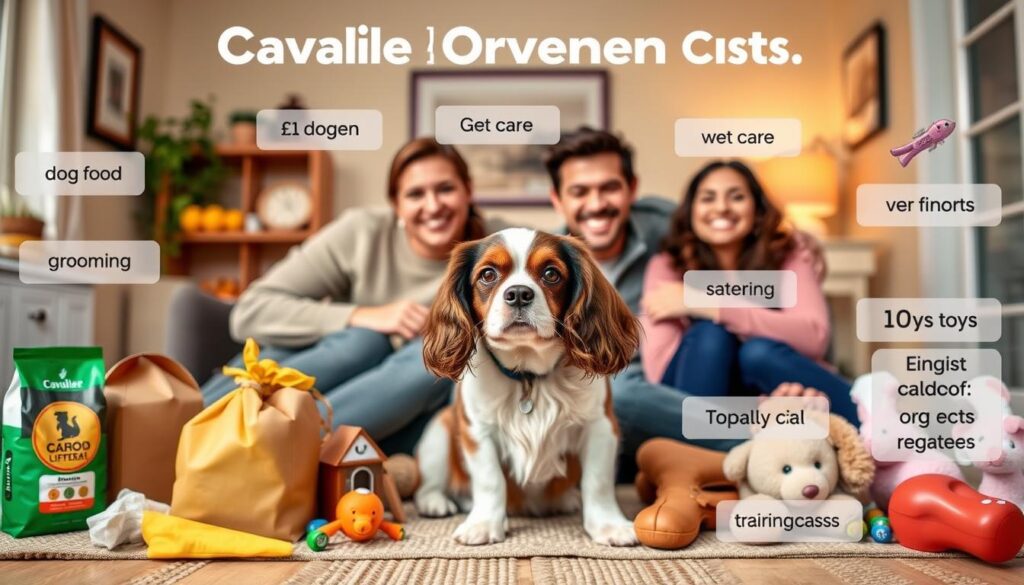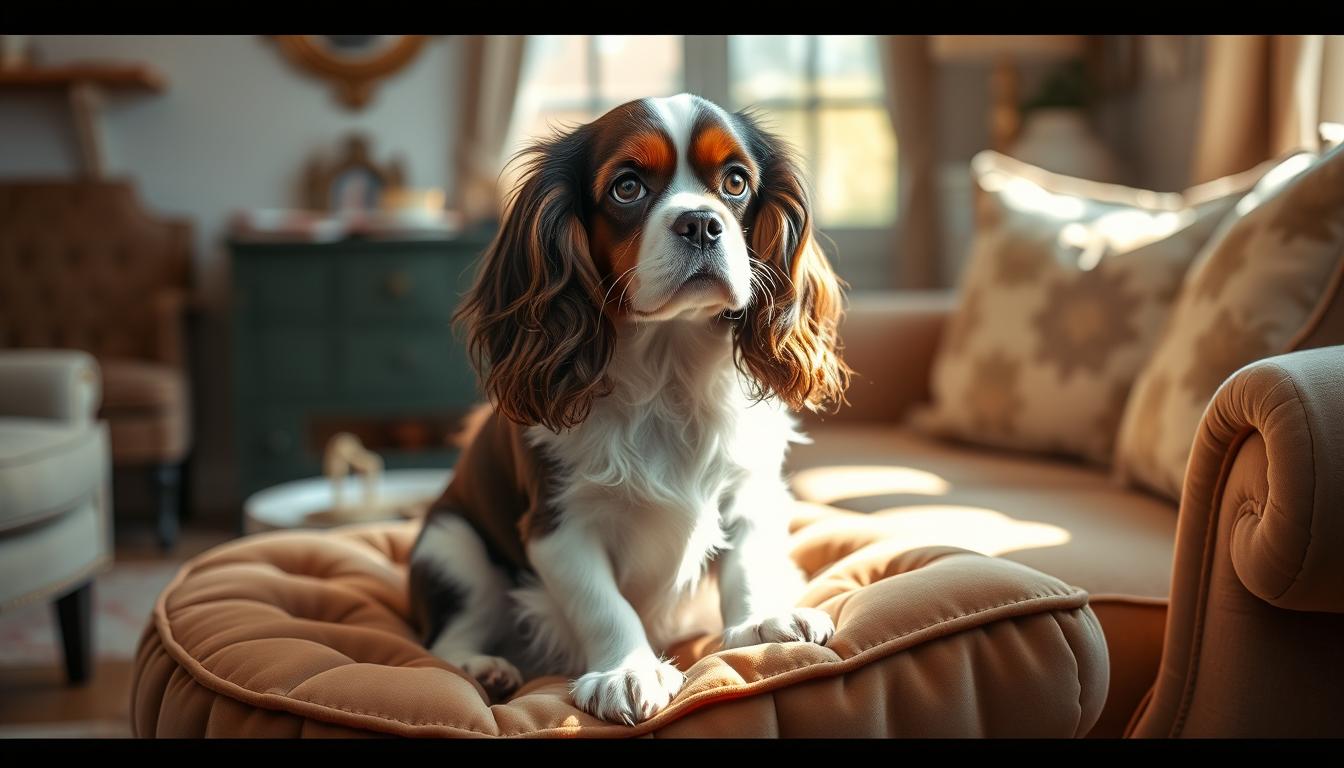The Cavalier King Charles Spaniel is a favorite for many. They are known for being gentle and loving. This makes them perfect for families and individuals.
They come from the United Kingdom and have a long history. Royal families have loved them for centuries.
Knowing about the breed’s history and traits is key. They are loyal and friendly, making them great companions. In the United States, they are popular for their loving nature.
The Cavalier King Charles Spaniel is a special breed. They offer a loving and loyal bond with their owners. They are perfect as a family pet or a companion.
With their rich history and gentle nature, it’s easy to see why they’re loved in the United States.
Key Takeaways
- The Cavalier King Charles Spaniel is a gentle and affectionate breed.
- They have a rich history and were a favorite among royal families in the United Kingdom.
- The Cavalier King Charles Spaniel is a great choice for families and individuals looking for a loyal companion.
- They are a popular breed in the United States due to their friendly and outgoing nature.
- Understanding the breed’s history and characteristics is essential for potential owners.
- The Cavalier King Charles Spaniel is a unique breed that offers a loving relationship to its owners.
The Rich Heritage of Cavalier King Charles Spaniels
The Cavalier King Charles Spaniel, or CKCS, has a long history. It was bred to be a royal companion in England. Its friendly nature made it a favorite among the royal family, spreading its popularity across the country.
The breed changed over time, becoming the modern CKCS we see today. Changes came from its purpose, living conditions, and owner preferences. This led to a unique breed with special traits.
Royal Origins and British History
The CKCS’s royal roots are well-known. It was a favorite of British monarchs, like King Charles II. Its small size, gentle nature, and love for people made it perfect for royal companionship.
Evolution of the Modern Cavalier
The modern CKCS came from careful breeding and selection. Its evolution was influenced by new breeds and breeding techniques. Now, it’s loved worldwide for its gentle and loving nature, making it a great family pet.
Recognition as a Distinct Breed
The CKCS was officially recognized as a distinct breed in the 20th century. Breeders and enthusiasts worked hard to define its unique traits. Today, it’s recognized by kennel clubs like the American Kennel Club (AKC) and the United Kennel Club (UKC).
Physical Characteristics of the Breed
The Cavalier King Charles Spaniel is a small dog with a gentle face. It’s a favorite Affectionate pet for many families. They weigh between 10-18 kg, fitting well in various homes because of their moderate energy.
Their coats are soft and silky. They need regular grooming to avoid matting.
Some key traits of the Cavalier King Charles Spaniel include:
- They are similar in size to a Toy spaniel, fitting well in different homes
- They are gentle and loving, great for families or those who want a companion
- They have soft, silky coats that need regular grooming to keep them looking good
The Cavalier King Charles Spaniel is a beautiful and loving breed. They are perfect for many owners, from families to individuals. They make great Affectionate pets like a Toy spaniel.
Understanding the Cavalier King Charles Spaniel Temperament
The Cavalier King Charles Spaniel is known for being gentle and affectionate. This makes it a great family pet. It’s important to know about Breed information and Health issues to help it thrive.
Gentle and Affectionate Nature
Cavalier King Charles Spaniels are friendly and outgoing. They love being around people. They get along well with children and other pets, especially if they’re socialized early.
Interaction with Children and Other Pets
When bringing a Cavalier King Charles Spaniel into your home, keep these points in mind:
- Always watch when the dog and kids are together
- Teach the dog basic commands
- Make sure the dog has a safe place to rest

Social Behavior Patterns
It’s key to understand how Cavalier King Charles Spaniels act socially. Knowing about Breed information and Health issues helps create a happy, healthy home for them.
Color Variations and Coat Types
The Cavalier King Charles Spaniel is a Cute dog breed with many colors. This makes it a unique and beautiful companion. The main colors are Blenheim, Tricolor, Black and Tan, and Ruby. Each color has its own charm, showing the breed’s diversity.
The Cavalier King Charles Spaniel has a coat that needs regular grooming. Its coat can be straight or slightly curly. Brushing it often helps prevent matting. A well-groomed Cavalier puppy is a joy to see, showing the breed’s gentle and loving nature.
Here are some key characteristics of the different color variations:
- Blenheim: a chestnut and white color combination
- Tricolor: a black, white, and tan color combination
- Black and Tan: a black coat with tan points
- Ruby: a solid red coat
Regardless of color, the Cavalier King Charles Spaniel is a beloved breed. It makes a wonderful companion with its gentle nature and adorable looks. Whether you’re looking for a Cavalier puppy or an adult dog, you’ll find a loyal and loving friend.
Training Your Cavalier Companion
As a Cavalier King Charles Spaniel owner, training is key. They are gentle and loving, making them easy to train with positive methods. This method rewards good actions, not punishing bad ones. It builds trust and strengthens your bond.
Training a Cavalier King Charles Spaniel needs patience and consistency. Begin with basic commands like sitting, staying, and coming when called. Use treats, praise, and affection to encourage good behavior. Socializing your dog is also vital. It makes them confident and calm in new places and with new faces.
Basic Obedience Training
- Start with short training sessions to keep your dog engaged and focused
- Use positive reinforcement techniques, such as treats and praise, to encourage good behavior
- Be consistent and patient, as training a dog takes time and effort
Socialization Tips
- Expose your dog to new environments, people, and animals from an early age
- Encourage socialization by taking your dog on regular walks and outings
- Consider enrolling your dog in puppy socialization classes to help them develop good social skills
Common Training Challenges
Cavalier King Charles Spaniels may face challenges like barking and separation anxiety. Stay calm and patient. Use positive reinforcement to encourage good behavior. With time and effort, your dog will become well-behaved and loyal.
Exercise Requirements and Activity Levels
The CKCS is not a high-energy breed, but they still need regular exercise needs to stay healthy and happy. Daily walks and playtime are key. But, it’s crucial not to overexert them, especially in hot weather. Aim for about 40 minutes of exercise daily, based on the dog’s age and growth stage.
Fun activities like agility, scentwork, and play can keep CKCS physically and mentally stimulated. For more info on creating a customized exercise plan, visit exercise needs for your CKCS.
Here are some tips to keep in mind:
- Start with short, gentle exercises and gradually increase duration and intensity
- Monitor your dog’s energy levels and adjust the exercise plan accordingly
- Make sure to provide plenty of water breaks and rest time
By following these guidelines and tailoring the exercise plan to your CKCS’s individual needs, you can help ensure they lead a happy, healthy life.
Grooming and Maintenance Needs
The Cavalier King Charles Spaniel has a beautiful coat that needs regular grooming. This is to prevent matting and tangling. They also need attention to their coat, nails, teeth, and ears to stay healthy and happy.
Regular grooming is key for the Cavalier King Charles Spaniel. It’s important to know how often to brush their coat. Also, don’t forget about nail, teeth, and ear care.
To keep your Cavalier King Charles Spaniel clean and well-maintained, consider these tips:
- Brush their coat 2-3 times a week to prevent matting and tangling
- Trim their nails every 4-6 weeks to prevent overgrowth
- Brush their teeth daily to prevent tartar buildup and promote good oral health
- Clean their ears weekly to prevent wax buildup and infections
Professional grooming is also necessary for the Cavalier King Charles Spaniel. It’s recommended to take your dog to a professional groomer every 6-8 weeks. This will help to keep their coat clean and healthy, and prevent any potential health issues.
By following these tips and staying on top of your Cavalier King Charles Spaniel’s grooming needs, you can help keep them happy and healthy for years to come.
Dietary Requirements and Nutrition
It’s vital to give your Cavalier King Charles Spaniel the right food. A balanced diet is key for their health. The right food depends on their age, size, and how active they are. You can learn more about what they need on dietary requirements for your pet.
Some important things to think about for your Cavalier King Charles Spaniel’s diet include:
- Feeding a diet rich in animal proteins
- Staying away from dry foods like kibble
- Keeping an eye on their weight to avoid obesity
Knowing what your Cavalier King Charles Spaniel needs can help prevent health problems. This way, they can live a happy and healthy life. For more tips on Nutrition and keeping your pet healthy, talk to a vet or a canine nutrition expert.
Health Considerations for Cavalier King Charles Spaniels
If you own a Cavalier King Charles Spaniel, knowing about common health issues is key. Health issues like mitral valve disease and syringomyelia can affect them. Understanding these can help you care for your dog better.
Regular health checks are vital for catching problems early. Your vet can spot issues and guide you on how to prevent them. Cavalier King Charles Spaniels may face heart problems, neurological issues, and obesity.
- Heart problems, such as mitral valve disease
- Neurological conditions, such as syringomyelia
- Obesity and related health issues
By working with your vet and taking care of your dog’s health, you can prevent or manage these issues. This way, your Cavalier King Charles Spaniel can live a long, healthy life. 
Knowing the signs of these health issues is also crucial. Look out for coughing, lethargy, or changes in appetite. If you see these signs, get your dog to the vet right away. Taking care of your dog’s health ensures they live happily and healthily with you.
Choosing a Cavalier Puppy
Finding a reputable breeder or rescue is key when choosing a puppy. This choice greatly affects your new pet’s health and happiness. A Cavalier puppy from a trusted source will be well-socialized and healthy.
Start by looking for breeders registered with national kennel clubs. These clubs have strict rules to ensure puppies’ health and quality. You can also get recommendations from friends, family, or vets who know Cavalier King Charles Spaniels.
Important things to think about when choosing a puppy include:
- Health clearances for the parents, such as heart and eye exams
- A clean and safe living environment for the puppies
- Positive reviews and testimonials from previous customers
- A guarantee or warranty for the health of the puppy
By researching and finding a reputable breeder or rescue, you’ll get a happy and healthy Cavalier puppy. This will make your new pet a joy for many years.
Living Space Requirements
The Cavalier King Charles Spaniel is a versatile breed that can thrive in various living situations. When considering bringing one home, it’s essential to evaluate your living space. This ensures it meets the breed’s needs. A suitable living space should provide enough room for exercise and comfort.
Some key factors to consider when assessing your living space include:
- Apartment living suitability: Cavalier King Charles Spaniels can adapt to apartment living, but they require regular exercise and attention.
- Outdoor space needs: While they don’t need a large yard, they do need regular opportunities for outdoor exercise and playtime.
Apartment Living Suitability
Cavalier King Charles Spaniels can make great apartment pets. However, it’s crucial to provide them with regular exercise and mental stimulation. This prevents boredom and destructive behavior.
Outdoor Space Needs
While a large yard is not necessary, Cavalier King Charles Spaniels do need regular outdoor exercise. This includes daily walks and playtime in a securely fenced area.
By understanding the living space requirements of the Cavalier King Charles Spaniel, you can create a comfortable and happy home for your new companion.
Cost of Ownership
Owning a Cavalier King Charles Spaniel is a big deal. It comes with many costs. The price to buy one can be between $1,000 and $5,000. It’s key to know the costs of owning a Cavalier King Charles Spaniel to care for them well.
Some ongoing costs include:
- Food and treats: $50 to $75 per month
- Grooming: $30 to $90 per session, depending on frequency and location
- Healthcare: $500 to $1,000 per year, including vaccinations, check-ups, and potential health issues
Also, think about insurance options for vet bills. The costs can pile up fast. But, with good planning, you can give your Cavalier King Charles Spaniel a great life.

Knowing the costs of owning a Cavalier King Charles Spaniel helps you make a smart choice. It’s a big responsibility. Make sure to put your Cavalier King Charles Spaniel’s needs first.
Show Ring Standards and Competition
If you own a Cavalier King Charles Spaniel and want to show it off, knowing the show ring standards is key. The American Kennel Club (AKC) has the breed standards for this dog. They focus on its gentle and loving nature.
In the show ring, judges look at the dog’s physical traits like its coat and size. They also check its temperament and how it behaves.
The Cavalier King Charles Spaniel should be of moderate size. Males should weigh 13-18 pounds, and females 10-15 pounds. Its coat can be many colors, like Blenheim, Tricolor, Black and Tan, and Ruby. This breed is known for being friendly, gentle, and outgoing.
If you want to compete with your Cavalier King Charles Spaniel, here’s what to do:
- Register your dog with a reputable kennel club, such as the AKC
- Ensure your dog meets the breed standards for size, coat, and temperament
- Train your dog to behave well in the show ring, including walking on a leash and responding to commands
- Attend dog shows and competitions to gain experience and exposure
By knowing the show ring standards and competition rules, you can show off your Cavalier King Charles Spaniel. It’s a rewarding experience for dog owners.
Making Your Home Cavalier-Ready
Before bringing your Cavalier King Charles Spaniel home, it’s key to get your living space ready. This makes sure it’s safe and comfy for your new pet. You need to home preparation to avoid any dangers.
First, keep all toxic stuff like cleaning supplies or meds out of reach. Also, set up a cozy spot for your Cavalier King Charles Spaniel, like a dog bed or crate.
Also, make your home safe by removing harmful items, like electrical cords or toxic plants. Block off areas you don’t want your dog to go into. Here’s what to do:
- Take away any dangerous items from the floor and surfaces
- Block off areas you don’t want your dog to go into, like certain rooms or areas with toxic stuff
- Give your dog a safe and comfy place to eat, sleep, and play
By doing these steps, you can make sure your Cavalier King Charles Spaniel has a smooth and safe move into its new home. Always put your dog’s safety and happiness first when getting ready for them.
Finding Your Perfect Companion: The Joy of Cavalier Ownership
Owning a Cavalier King Charles Spaniel is incredibly rewarding. These dogs are loyal and affectionate, becoming part of the family. They bring joy and companionship for their whole life.
These dogs have a gentle and playful nature. They have a charm that wins hearts. Anyone who meets them is captivated.
The bond between a Cavalier and their owner is special. They love being around people and crave attention. Whether relaxing at home or going on adventures, they’ll always be there for you.
If you’re looking for a furry friend, consider a Cavalier King Charles Spaniel. They adapt well, are easy to train, and love family. Get ready to be charmed by their looks, personality, and the bond you’ll share.
FAQ
What are the origins of the Cavalier King Charles Spaniel?
The Cavalier King Charles Spaniel has a long history. It started in the royal courts of England. They were bred as royal companions, loved for their friendly and gentle nature.
What are the physical characteristics of the Cavalier King Charles Spaniel?
This breed is small and has a gentle look. They weigh 10-18 kg and have a moderate energy level. Their coats are soft and silky, needing regular grooming.
What is the temperament of the Cavalier King Charles Spaniel?
They are known for being gentle, affectionate, and playful. This makes them great family pets. But, they can have health issues and need proper care.
What are the different color variations and coat types of the Cavalier King Charles Spaniel?
They come in colors like Blenheim, Tricolor, Black and Tan, and Ruby. Each color is unique and beautiful. Knowing about their coat types and how to care for them is important.
How do I train a Cavalier King Charles Spaniel?
Training is key for this breed. They are gentle and respond well to positive training. This includes basic commands, socialization, and handling common challenges.
What are the exercise requirements and activity levels of the Cavalier King Charles Spaniel?
They need regular exercise but are not high-energy. Daily walks and play are important. But, don’t overexert them, especially in hot weather.
What are the grooming and maintenance needs of the Cavalier King Charles Spaniel?
Their beautiful coat needs regular grooming to prevent mats. They also need nail trimming, teeth brushing, and ear cleaning to stay healthy.
What are the dietary requirements and nutrition needs of the Cavalier King Charles Spaniel?
A balanced diet is essential for their health. The right food depends on their age, size, and activity level.
What are the common health considerations for Cavalier King Charles Spaniels?
They are prone to mitral valve disease and syringomyelia. Knowing about these conditions and taking preventive steps can improve their life. Regular health checks are also important.
How do I choose a Cavalier King Charles Spaniel puppy?
Choosing a puppy is a big decision. Look for reputable breeders and ensure health clearances. Prepare for the first few weeks with your new puppy.
What are the living space requirements for a Cavalier King Charles Spaniel?
They can live in various places, from apartments to homes with yards. They need regular exercise and attention.
What are the costs associated with owning a Cavalier King Charles Spaniel?
Owning one comes with costs, from the initial purchase to ongoing expenses. This includes food, grooming, and healthcare. Pet insurance is also a consideration.
What are the show ring standards and competition requirements for Cavalier King Charles Spaniels?
For showing, understanding breed standards and competition requirements is key. This includes their physical characteristics and temperament.
How do I prepare my home for a Cavalier King Charles Spaniel?
Before bringing them home, prepare your space. Secure toxic substances, prepare a comfy sleeping area, and dog-proof your home.

